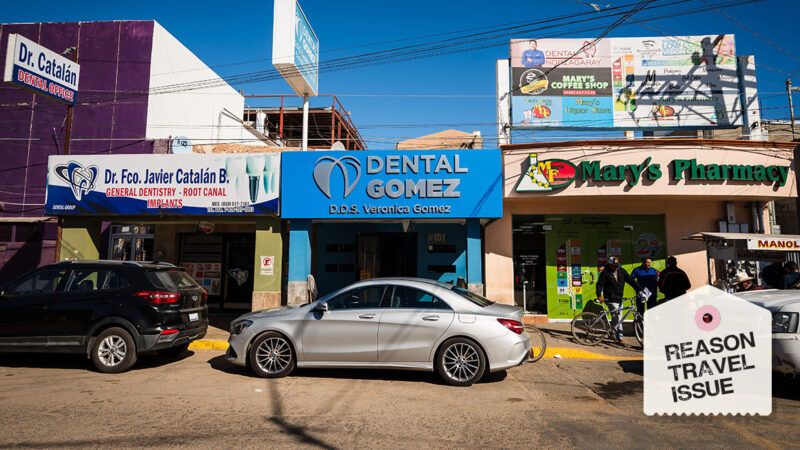The Glories of Mexican Dentistry
"I needed some extensive and expensive dental work, and so I crossed borders."

This is part of Reason's 2025 summer travel issue. Click here to read the rest of the issue.
I crossed the U.S./Mexico border six times in a month in 2018, an economic refugee in my own way.
While the consumer price index indicates an overall U.S. inflation rate of around 85 percent since 2000, over that same period inflation in dental costs was more like 133 percent, according to the Bureau of Labor Statistics.
I needed some extensive and expensive dental work, and so I crossed borders seeking my own version of a better (in my case, more affordable) life, sometimes under the piercing gaze of the federales. I occasionally drove through U.S. border inspection, many dozens of miles from the border on Interstate 8, being ordered via signs to come to a stop while an agent glanced at my car without actually engaging me in any conversation or even making me turn off the vehicle.
Mexico could not have cared less about this border crossing back then; no one asked for your papers, por favor, as you strolled unimpeded from the parking lot on the U.S. side and entered Algodones from Winterhaven, California, at the Andrade border crossing. According to my Mexican dentist, nearly 13,000 tourists enter there on an average winter day. Algodones is a dental and optical retail paradise; the three blocks I walked to my dental destination were all storefronts selling those services, along with some pharmacies.
Reentering the U.S., however, required standing in a line that was always 45–60 minutes long. At the end you had to show a bored customs officer a passport and answer questions about what you had bought in Mexico. Such answers, at least from a white dude then in his late 40s, were casually believed. If you were driving a car back, you were likely to have a black-suited police officer walk a big menacing looking grey-black dog by your car as it waited in the long line to return to the land of high dental prices.
I was a day tourist in Algodones to replace a three-unit dental bridge first installed about 10 years earlier by a Los Angeles dentist. It had become uncemented about four years prior. I had paid American dentists to recement it three times, and finally it just broke and could no longer be reattached.
Anywhere near where I live in California, getting a new one made and installed would have cost around $5,000 then; I got out for $1,300 in Algodones, a fee (paid in U.S. dollars cash) that covered three visits, a deep cleaning, and a root canal in addition to making and installing the bridge.
In terms of bedside manner and the general attitude toward patient-doctor relations, I had an experience unlike any I'd had with an American dentist. I was treated in Mexico as a customer, not a ward. If they suggested work more elaborate or pricey than I felt like spending—and they did—the conversation ended with my demurral.
I've had American dentists straight up refuse to do any ameliorative work short of the more thorough and expensive suggestion they repeated to me incessantly to try to break down my resistance while I was sitting prone in their chair. Now, my desires don't match those of all American patients, who according to some trend watchers in dentistry want more preventative, holistic, and membership-based work. I'm usually looking to solve an immediate issue that I physically perceive as a problem, and to do it with as little rigamarole and cost as I can. It's great for me, and people like me, that the Algodones option is there. (Even prior to post-COVID inflation, 15 percent of Americans already said that cost kept them from dental care.)
There was one aspect of the experience I didn't love. I'm a bit of a radiation hypochondriac, and they were very casual about shielding you with lead bibs when X-raying you; unless you insisted, they would not do it. While I cannot judge on a professional regulatory level, their general hygiene practices otherwise seemed to match those of a typical American dentist, and I certainly never felt any ill effects.
As far as my needs went, the work seems to be of long-term quality equal to the American work that cost more than four times as much. While I will never know if this is a fault of the Mexican work or an inevitability in any case, the teeth beneath the bridge six years down the line reached a state of rot that led to a gum and sinus infection, or so an American physician believed. So though the bridge was still solidly in place, I had it pulled to extract the husks of teeth underneath it. Nothing is forever. The very fact I had to have this work done in Mexico was because of the lack of permanence of the more than $4,000 bridge I had put in about a decade prior.
Over all fields, Americans are spending around $4 billion a year on foreign medical care, and that's likely to grow by about 13 percent a year over the rest of the decade. Dentists themselves are complaining these days that their costs are outgrowing their revenue, and profits and access to hygienists are both being strained. The range of conditions that make dentistry so much more affordable in Mexico include some elements that an American of any income level might not want to be completely enveloped in, such as far lower wages for professionals and their associates, and cheaper overhead from an atmosphere of less prosperity and demand.
But that's why it's good to be able to take advantage of the elements that are better on either side of the border.
